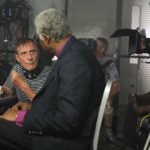
Soft Water
Posted on May 9, 2018 by Julian Mitchell
 Dan wanted Sally Hawkins’ character to look as if she has ‘this glow coming from inside’.
Dan wanted Sally Hawkins’ character to look as if she has ‘this glow coming from inside’.
In a highly technical digital movie some old Hollywood techniques carried the narrative
When Guillermo del Toro, the director of The Shape Of Water, called DOP Dan Laustsen about a story that involved a mute cleaner’s relationship with a merman, Dan wasn’t alarmed: “I’ve got used to the storylines from Guillermo.” Dan had previous experiences of shooting movies with del Toro, including Crimson Peak which in comparison was a more run-of-the-mill, ‘evil brother and sister cooped up in a bleeding, breathing and very haunted house’ type of story. “I’ve done three movies with Guillermo. Firstly Mimic in 1996, and then we had a break for 20 years. Then he called me to do Crimson Peak, where he told me about the idea for The Shape Of Water. A working-class mute falling in love with a fish man. If someone else had told me about it, I would think he was mad. Guillermo’s world is always fantastic but then he added, ‘By the way, we have to shoot in black & white’.”
As most DOPs know, the challenge of shooting in black & white is a big ambition for many of them. Unfortunately we now know it fell apart because they couldn’t find the money. “We went back to colour and I think this was a very clever decision because the colours became a big part of the movie.
“We knew that we wanted to have a period looking movie and also wanted to have classic lighting. Single source lighting with deep shadows but still with some details and some sweetness in the highlights. In this world it would be greens, teal, steel blue. Sally Hawkins, who plays the mute, is such a strong character,she has to look like she has this glow coming from inside. She should never look like a beaten-down, working-class woman. She should have this princess-like look from the beginning. This look should get stronger and stronger as the movie goes on and as she gets more and more powerful and falls more in love with the fish man.
“That was something we talked about when we were prepping the movie. So we decided to light her very classically, very old Hollywood. We wanted to go more 40s or 50s but when you’re shooting digitally you have to use more soft light. In the old days those guys would use more hard light. I don’t think that works for colour in digital, it looks wrong. We tried to do a couple of tests like that and we didn’t like it. So we went back to this super-soft close-up design which was very directional so she had a dark side as well.”
 The movie needed to have a classic, old Hollywood soft look.
The movie needed to have a classic, old Hollywood soft look.
Dan designed this lighting idea just for Sally’s character and mixed it with a more one-dimensional dark design for the bad guys. “They should be a little bit more contrasty with more side lighting and a little bit more dramatic camera angles and deep shadows. I think that works really well but of course you cannot cheat too much as you might make it too artificial. We are using filtration all the way through; initially we were planning on diffusing Sally but with the ARRI ALEXA XT you can put a filter behind the lens. I think it was a quarter black Pro-Mist we had in there. We started only using it for Sally but it didn’t work out for me, it was getting too weird. So we decided to go with the Pro-Mist all the way through. I think it works pretty well with the XT and Master Primes.
“I’m a big fan of Master Primes, I think they are fantastic lenses and do a really good job. We don’t want any surprises, with the way we are designing the movie and the look, we want to be able to control everything. These lenses are unforgiving but they are still giving you exactly what you’re asking for. It’s not like ‘by the way we have a flare there’ or something like that. If you want to have a flare you have to do it yourself. I really like that.
We’re not using the whole set, most of the shots are between 21mm and 32mm. A lot of them are 21mm, 25mm and 27mm. We never used long lenses and only used one camera although we had a B camera.”
Colour palette
 Director Guillermo del Toro on set with Sally Hawkins and Octavia Spencer.
Director Guillermo del Toro on set with Sally Hawkins and Octavia Spencer.
Each Guillermo del Toro movie is evolved using a succinct colour palette. This is shorthand for the DOP and production designer to pick up and run with. “We are talking a lot about the colours of the walls, comparing them to skin tones, wardrobes and set design. Everything is blending in together and because all the colours are so specific we’re kind of doing the colour correction on the set. The colours we’re shooting on set were the exactly the same colours in the movie, we didn’t change anything colour wise when I did the DI.”
 DOP Dan Laustsen on set with Guillermo.
DOP Dan Laustsen on set with Guillermo.
The lighting design hinged on the close-up design but there were still a lot of lights around for wider shots. Dan also had a distinct idea for shooting with certain focal lengths. “I prefer to shoot 3.5, between 2.8 and 4.0, so you know we need a lot of light actually, as I’m not a full open shooter. So there is a lot of light in the sets; mostly LED and the practicals are doing their job. This was a small budget movie so we could afford all ARRI lighting. We had to use all kinds of different lights because of this tight budget. It’s fine, you just have to work around it.
Is it water?
 Dan’s colour palette included lots of greens, blues and teal.
Dan’s colour palette included lots of greens, blues and teal.
As the movie gets more attention due to its many nominations, the news of how they shot with water is coming out. The truth was that much of the start and finish was shot dry for wet. “The opening scene and the ending scene were shot with what we call ‘dry for wet’. This means that there was no water at all. So the trick is to fill the studio up with a lot of smoke; and we’re talking about lots of it. Also instead of having film light you have film projectors so you can project, like a Gobo light, what you look like when you are below the water because the light is moving around a little bit. Then of course the visual effects guys are putting fish in and bottles and all that kind of stuff. So the beginning and the end of the movie are shot like that and then you’re shooting high speed to get the movement a little bit slower. The VFX guys also have to put the hair in as you need that effect of floating water.
“I’ve never used the technique before, I think it’s an old trick from the theatre. But I think we did it really well especially at the beginning as we were setting this weird tone. We just wanted to warn the audience that this is a normal movie but a little bit weird at the same time. It’s a little bit unsettling from the start.”
“There is a tank used in the middle of the movie when Sally’s character and the merman are together but of course the problem using real water is that people can’t perform. You can’t really open your eyes properly. That middle sequence was just a matter of coming up for air and getting through it. In the opening she is lying on the sofa for about two minutes and that would never be possible under water.
 Sally Hawkins and Richard Jenkins.
Sally Hawkins and Richard Jenkins.
“We couldn’t afford to build a big tank and there were no really big tanks around Toronto where we shot. A lot of people I’ve spoken to, even filmmakers, didn’t know it was faked. They were saying, ‘that tank must be pretty big’. It works really well and the first shot is a long Steadicam shot so the camera’s really floating in there.”
Movement for edit
In fact most of the shots are Steadicam or shot with a jib arm on a dolly with a hot head on. “Most of the shots are designed by me and Guillermo. The way he is editing the movie is to shoot in a linear fashion, all set-ups are designed to go next to each other. The takes are more or less the length that they will be in the movie. The only person who can design that is Guillermo because he’s got to cut it together. Guillermo is so precise about his editing, the design of the shoot is mostly from him. He is shooting very chronologically so we have to turn around a lot. Of course that’s a bit painful as a cinematographer because you have to come back to the same lighting set-ups and some of those were pretty complicated to replicate. But you get used to that. Normally you shoot in one direction in the morning and then you’re turning around in the afternoon. We’re turning around all the time!”
 Guillermo del Toro, Dan Laustsen, cast and crew.
Guillermo del Toro, Dan Laustsen, cast and crew.








